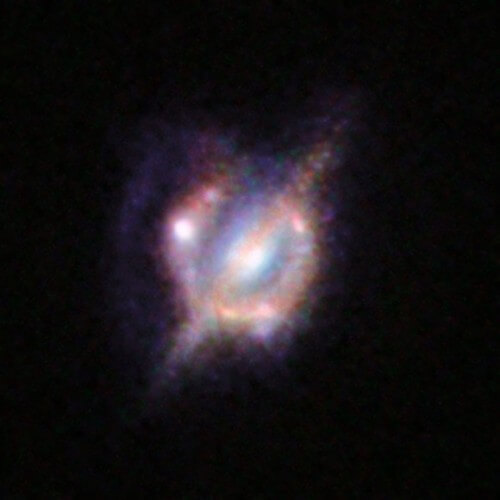An international team of astronomers managed to capture the best image yet of a galaxy collision that occurred when the universe was half its age today

An international team of astronomers managed to capture the best image yet of a galaxy collision that occurred when the universe was half its age today.
The team combined observations from ground telescopes including Alma, Mitzpe Kek, the Very Large Array as well as the Hubble Space Telescope. However, luck also played a role when between these galaxies and us stood a galaxy that created a cosmic void.
According to Hugo Macias, from the University of Concepción in Chile, and the Center for Astronomy in Lisbon, Portugal, the lead researcher in the cosmic dust project, it is a rare and visually deceptive event, in which a large body - a galaxy or a cluster of galaxies - stands between us and a distant body, bending the light of the distant body and amplifying it. Gravitational lensing allows researchers to observe objects that would otherwise not be visible to the eye and compare nearby galaxies with distant galaxies, as they appeared in the universe when it was younger.
The distant object, dubbed H-ATLAS J142935.3-002836, was identified by the Herschel Large Survey (H-ATLAS). . Although it appears faint in the images, it is among the brightest gravitational clouds in the far infrared region.
The combination of Hubble and Keck images shows that the foreground galaxy is a spiral galaxy similar to the Milky Way, seen from the side. Although the galaxy's gas clouds obscure some of the background light, both ALMA and the VLA can view the sky at longer wavelengths, which are unaffected by the dust. The combined data showed that the background system is actually an ongoing collision between two galaxies.
The team found similarities between these systems and a much closer one: the Antennae Galaxy, which consists of two galaxies that spent the last few hundred million years in a swirling embrace before merging with each other. The researchers were able to verify this hypothesis with the help of the telescope systems at the Alma Observatory. They have a unique ability to detect carbon monoxide emissions, unlike other telescopes, which are only able to investigate the absorption along the line of sight. This allowed astronomers to measure the velocity of the gas in the more distant core. Using this information, they were able to show that the dwarf object is an ongoing collision of galaxies.
Collisions of this type naturally enhance the rate of star formation. Any clumps of gas inside the galaxies would feel a headwind, which would cause them to compress enough to cause star formation. Indeed, Alma's observation shows that both galaxies produce hundreds of new stars each year.
"Alma allowed us to solve this puzzle and provided data on the velocity of the gas in the galaxies that allow us to separate the different components. The observation also reveals the classic signature of a galaxy merger," said the scientific director of the European Southern Observatory (ESO) and co-author of the new study, Rob Ibison. "This new study captures the merger of galaxies, which was a catalyst for a massive stream of star formation."
The findings were published in the August 26 issue of the journal Astronomy and Astrophysics And it is available online .
